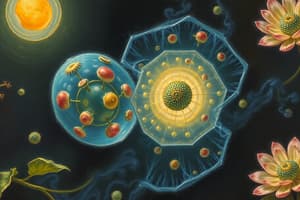Podcast
Questions and Answers
What is homeostasis?
What is homeostasis?
Relative uniformity of the normal body's internal environment.
What is negative feedback?
What is negative feedback?
Negate a change in a controlled condition.
What is positive feedback?
What is positive feedback?
Amplify the change that is occurring.
What is the structure of an atom?
What is the structure of an atom?
What defines a molecule?
What defines a molecule?
What are compounds?
What are compounds?
What are ionic bonds?
What are ionic bonds?
What are covalent bonds?
What are covalent bonds?
What does pH measure?
What does pH measure?
What are the three main parts of a cell?
What are the three main parts of a cell?
What is the function of the plasma membrane?
What is the function of the plasma membrane?
What are ribosomes known as?
What are ribosomes known as?
What is the endoplasmic reticulum's (ER) function?
What is the endoplasmic reticulum's (ER) function?
What does the Golgi apparatus do?
What does the Golgi apparatus do?
What are mitochondria known as?
What are mitochondria known as?
What is the function of lysosomes?
What is the function of lysosomes?
What are centrioles involved in?
What are centrioles involved in?
What is the role of cilia?
What is the role of cilia?
What is flagella?
What is flagella?
What is the nucleus's function?
What is the nucleus's function?
What is the role of nucleoli?
What is the role of nucleoli?
What is ATP?
What is ATP?
What is passive transport?
What is passive transport?
What is active transport?
What is active transport?
What is diffusion?
What is diffusion?
What is osmosis?
What is osmosis?
What is mitosis?
What is mitosis?
What is the cell division sequence?
What is the cell division sequence?
What is interphase?
What is interphase?
What are tissues?
What are tissues?
What are the four types of tissues?
What are the four types of tissues?
What does epithelial tissue do?
What does epithelial tissue do?
What is simple squamous epithelial?
What is simple squamous epithelial?
What is stratified squamous epithelial?
What is stratified squamous epithelial?
What are the shapes of epithelial cells?
What are the shapes of epithelial cells?
What is connective tissue?
What is connective tissue?
What are the types of muscle tissue?
What are the types of muscle tissue?
What is the function of nervous tissue?
What is the function of nervous tissue?
Flashcards are hidden until you start studying
Study Notes
Homeostasis and Feedback Mechanisms
- Homeostasis maintains a stable internal environment within the body.
- Negative feedback mechanisms counteract changes in a controlled condition, e.g., sweating and shivering.
- Positive feedback mechanisms enhance or amplify changes, such as during labor contractions.
Atomic Structure
- Atoms consist of a nucleus, containing protons (positive) and neutrons (neutral), surrounded by electrons (negative).
- Atomic number indicates the number of protons, defining the type of atom.
- Atomic mass is the sum of protons and neutrons in the nucleus.
Molecules and Compounds
- Molecules are groups of atoms bonded together.
- Compounds consist of molecules with more than one type of atom.
Chemical Bonds
- Ionic bonds form when atoms transfer electrons, leading to attraction between oppositely charged ions (e.g., table salt).
- Covalent bonds occur when atoms share electrons, creating more stable structures; these do not easily dissolve in water.
pH Levels
- pH measures the concentration of hydrogen ions in a solution.
- A pH of 7 is neutral; values above 7 are basic, and below 7 are acidic. Blood has a pH of 7.4.
Cell Anatomy
- Cells have three main parts: plasma membrane, cytoplasm, and nucleus.
- The plasma membrane acts as a boundary, with proteins and carbohydrates serving functional roles.
- Ribosomes function as protein synthesis sites.
Endoplasmic Reticulum and Golgi Apparatus
- Rough ER synthesizes and transports proteins; Smooth ER produces lipids and certain carbohydrates.
- Golgi apparatus packages and delivers proteins from the ER, functioning like delivery services.
Energy Production and Cell Functions
- Mitochondria are known as the powerhouses of the cell, generating ATP, the energy currency.
- Lysosomes act as the cell's digestive system, breaking down waste materials.
- Centrioles are involved in cell reproduction processes.
Cell Movement Structures
- Cilia facilitate the movement of substances over cell surfaces.
- Flagella, like the tail of a sperm cell, aid in cellular propulsion.
Nucleus and Nucleoli
- The nucleus contains the cell's genetic blueprint and directs cellular function.
- Nucleoli are crucial for ribosome formation.
Transport Mechanisms
- Passive transport (e.g., diffusion, osmosis) does not require energy.
- Active transport involves energy usage to move substances against their concentration gradient.
Types of Cell Transport
- Diffusion is the scattering of substances to achieve uniformity (e.g., sugar in water).
- Osmosis regulates water movement; isotonic solutions have balanced salt and water, while hypertonic solutions draw water out of cells and hypotonic solutions force water into cells.
Cell Division and Tissues
- Mitosis is the process of cell division for multiplication.
- Cell division consists of phases: prophase, metaphase, anaphase, and telophase.
- Interphase is a resting period where DNA replication occurs before mitosis.
Tissue Types
- Tissues are groups of cells working together, classified into four main types: epithelial, connective, muscle, and nervous.
Epithelial Tissue Characteristics
- Epithelial tissue covers the body and lines various organs.
- Simple squamous epithelial is one cell thick and facilitates substance transport (e.g., in lungs).
- Stratified squamous epithelial consists of multiple cell layers (e.g., soles of feet).
Connective, Muscle, and Nervous Tissues
- Connective tissue is the most widespread, found in skin, organs, and bones.
- Muscle tissue includes skeletal (voluntary), cardiac (involuntary), and smooth (involuntary), forming walls of blood vessels and organs.
- Nervous tissue enables rapid communication and control of body functions.
Studying That Suits You
Use AI to generate personalized quizzes and flashcards to suit your learning preferences.




